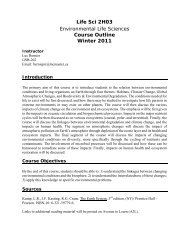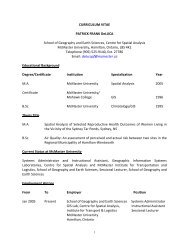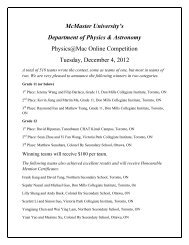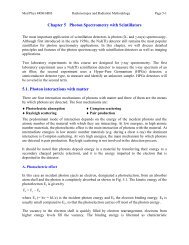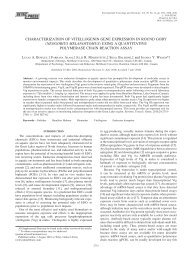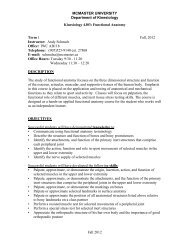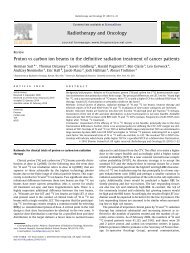Lecture 7 - McMaster University
Lecture 7 - McMaster University
Lecture 7 - McMaster University
You also want an ePaper? Increase the reach of your titles
YUMPU automatically turns print PDFs into web optimized ePapers that Google loves.
Acute Radiation Syndromes<br />
<strong>Lecture</strong> 7<br />
May 24, 2012
What is Acute Radiation Syndrome (ARS) ?<br />
An acute illness caused by irradiation of the entire body by a high dose<br />
of penetrating radiation in a very short period of time.<br />
Conditions for Acute Radiation Syndrome:<br />
• The radiation dose must be large<br />
• The dose usually is external<br />
• The radiation is penetrating<br />
• The entire body<br />
• The dose must have been delivered in a short time (acute)
Acute Radiation Syndrome<br />
Lethal Dose (LD) 50 - the dose that will kill<br />
50% of the population.<br />
LD 50 (1) – means lethal dose to kill 50% of<br />
population within 1 day.
3 Types of Acute Radiation Syndrome are:<br />
• Hematologic (Bone Marrow) Syndrome<br />
• Gastrointestinal (GI) Syndrome<br />
• Central Nervous System (CNS) Syndrome
The 4 stages of Acute Radiation Syndrome are:<br />
• Prodromal stage- 1 st set of symptoms occurs. (nausea, vomiting,<br />
diarrhea)<br />
• Latent stage- patient looks and feels generally healthy<br />
• Manifest illness stage- prodromal stage symptoms reoccur along with<br />
additional symptoms<br />
• Recovery or death stage- Most patients who do not recover will die<br />
within several months of exposure.
• Occurs between 1 Gy and 10 Gy<br />
•<br />
• Death occurs within 6-8 weeks at doses of 2 Gy for some individuals<br />
• Death is caused by reduction of:<br />
red blood cells<br />
white blood cells<br />
platelets<br />
• Death results from anemia and infection
Prodromal Stage:<br />
• Occurs 1 hour to 2 days after exposure<br />
• Symptoms are anorexia, nausea and vomiting.<br />
• Stage lasts for minutes to days<br />
Latent Stage:<br />
• Occurs from a few days up to 3 weeks after exposure<br />
• Stem cells in bone marrow are dying, even though the patient may look<br />
and feel well<br />
Manifest Illness Stage:<br />
• Reduction in blood cell count<br />
• Occurs 3-5 weeks after exposure<br />
• Symptoms are cytopenia, which causes anemia and infections
Recovery or death stage:<br />
• 1.0 – 3.0 Gy bone marrow cells will begin to repopulate enough to<br />
sustain an individuals life span.<br />
• During the 3 rd week – 6 months a large percentage of these individuals<br />
will fully recover.<br />
• 4.0 – 6.0 Gy will have fewer survivors<br />
• 10.0 Gy no survivors<br />
• Survival decreases with increase in dose
• Occurs due to damage of the GI tract lining (bone marrow is done)<br />
• Occurs with a dose of plus 10 Gy<br />
• Symptoms appear at a threshold dose of about 6.0 Gy<br />
• Survival time does not vary with dose<br />
• Death happens at the same time regardless of the dose received
Prodromal Stage:<br />
• Occurs within hours after exposure<br />
• Symptoms are nausea, vomiting, cramps and diarrhea<br />
Latent Stage:<br />
• Occurs though the fifth day<br />
• Stem cells in bone marrow and cells lining GI tract are dying, even<br />
though patient may look and feel well.<br />
Manifest Illness Stage:<br />
• Reoccurrence of nausea, vomiting and diarrhea along with a fever<br />
• Occurs from the fifth through the tenth days<br />
Recovery or death stage:<br />
• GI tract attempts regeneration after irradiation<br />
• Death results from infection, dehydration and electrolyte imbalance<br />
• Death occurs within 2 weeks of exposure
• Occurs at radiation doses of 50-100 Gy<br />
• Death occurs in hours or sometimes 2-3 days after exposure<br />
• CNS damage results from damage to the blood vessels that supply the<br />
system, causing:<br />
Edema- (swelling) in the cranial vault<br />
Vasculitis- inflammation of blood vessels<br />
Meningitis- inflammation of the spinal cord and brain<br />
membranes<br />
• Death is caused by increased pressure in the cranial vault as a result of<br />
elevated fluid content
Prodromal Stage:<br />
• lasts for minutes to a few hours<br />
• Symptoms are nervousness, confusion, severe nausea, vomiting,<br />
diarrhea, loss of consciousness, and burning sensations of the skin<br />
Latent Stage:<br />
• Last for several hours<br />
• Patient may return to partially functional state<br />
Manifest Illness Stage:<br />
• Occurs 5-6 hours after exposure<br />
• Symptoms are diarrhea, convulsions, coma and death<br />
Recovery or death stage:<br />
• No recovery is expected<br />
• Death occurs within 3 days<br />
Vasculitis �
Hematologic Syndrome is the destruction of bone marrow<br />
caused by a reduction in production of red blood cells, white<br />
blood cells and platelets resulting from radiation exposure.<br />
Death may occur as a result of anemia and infection.<br />
Gastrointestinal syndrome is exhibited by nausea , vomiting,<br />
diarrhea as a result of damage to the villi in the small<br />
intestine which leads to lack of absorption. Resulting in<br />
dehydration and Infection.<br />
Central Nervous System Syndrome is exhibited by<br />
nervousness, confusion, nausea, vomiting, loss of<br />
consciousness, and a burning sensation of skin which are the<br />
result of damage to blood vessels and increased intracranial<br />
pressure.
Acute Radiation Syndromes:<br />
Radiation Accidents
• Since 1945 there have been at least 60 criticality accidents. These have caused at least 21 deaths: seven in the United States,<br />
ten in the Soviet Union, two in Japan, one in Argentina, and one in Yugoslavia. Nine have been due to process accidents,<br />
with the remaining from research reactor accidents.<br />
• On 4 June 1945, Los Alamos scientist John Bistline was conducting an experiment to determine the effect of surrounding a<br />
sub-critical mass of enriched uranium with a water reflector. The experiment unexpectedly became critical when water<br />
leaked into the polyethylene box holding the metal. Three people received non-fatal doses of radiation.<br />
• On 21 August 1945, Los Alamos scientist Harry K. Daghlian, Jr. suffered fatal radiation poisoning after dropping a tungsten<br />
carbide brick onto a sphere of plutonium, which was later nicknamed the demon core. The brick acted as a neutron<br />
reflector, bringing the mass to criticality. This was the first known criticality accident causing a fatality.
• Harry K. Daghlian<br />
Video
Accidents And Emergencies<br />
- Populations (Chernobyl)<br />
- Individuals (Thailand)<br />
Chernobyl<br />
Bangkok, Thailand
• RBMK-1000 reactors<br />
Chernobyl NPP<br />
before the accident<br />
• Units 1-4 online 1977-1983, producing ~10% of<br />
Ukraine’s power<br />
• Units 5-6 under construction<br />
• Total of 12 units planned
• Occurred at 1:24 am<br />
April 26, 1986<br />
• Attempting test during<br />
routine shutdown of<br />
unit 4<br />
• Massive steam explosion<br />
followed by fuel vapour<br />
explosion, and fires<br />
• Design and operator<br />
errors to blame<br />
Chernobyl NPP<br />
the accident<br />
Courtesy of Viktor Krasnov
Chernobyl NPP<br />
after the accident<br />
• Approximately 5000t of material (boron,<br />
dolomite, lead, sand and clay) dumped on core<br />
• May 5, 1986 fire extinguished<br />
• Oct-Nov 1986 units 1 and 2 back online<br />
• Dec 1987 unit 3 operational<br />
• Dec 1991 fire in unit 2, shutdown permanently<br />
• 1996 unit 1 taken offline<br />
• 2000 unit 3 taken offline
• 28 deaths within weeks<br />
directly resulting from<br />
acute radiation syndrome<br />
– 20 received 6-16 Gy,7 4-6<br />
Gy and 1 received 2-4 Gy<br />
• 600,000 people classified<br />
as ‘liquidators’<br />
• 116,000 people<br />
evacuated in 1986,<br />
another 220,000<br />
relocated after 1986<br />
Chernobyl NPP<br />
effects
Accident Biological Dosimetry<br />
Bangkok, Thailand
Accident History<br />
•Location : Samutprakarn Province (10 km south of Bangkok)<br />
•10 people admitted to hospital for radiation sickness<br />
•exposure Feb. 1, 2000 to Feb. 18, 2000<br />
•Office of Atomic Energy for Peace (OAEP) notified Feb 18
Accident (Feb 1-18, 2000)<br />
•3 people died<br />
•9 people had clinical symptoms (ARS), 4 received<br />
doses over 6 Gy<br />
•1263 people examined<br />
•824 blood samples were counted<br />
•28 blood samples collected by <strong>McMaster</strong><br />
<strong>University</strong> for cytogenetics (May 2000 ~ 3 and 16<br />
months later)<br />
•12 samples sent to AFRRI (PCC)
The 60 Co Source<br />
•Problem - 3 improperly stored teletherapy<br />
units<br />
•1 unit was dismantled (100kg<br />
cylinder removed, 10” diameter x 20”<br />
long)<br />
•cylinder was cut open releasing<br />
source<br />
1”<br />
2”
Building<br />
7.05m<br />
1.46m<br />
3.35m<br />
18.50m<br />
Yard<br />
Co-60<br />
5.98m<br />
425-450 Ci<br />
7.0m<br />
26.08 m<br />
1 meter ~ 2 Sv/h
Radiation burn on both hands of P /LS ( taken on
Radiation burn on both hands of P /LS ( taken on
Epilation and skin lesion of P /NP
Acute radiation syndrome<br />
Relation between the proportion of people with severe<br />
epilation (loss of more than 2/3 of hair) and estimated<br />
radiation dose.
Case Study: Nesvizh, Belarus<br />
Irradiation Facility Accident
Case Study: Nesvizh (cont)<br />
• 26 October 1991<br />
• 1890 Ci Co-60 source used for steralization of<br />
medical syringes & sponges<br />
• 34 year old experienced operator<br />
• 03:40 jam occurs in transport mechanism<br />
(decoupling of linkage arms)<br />
• Operator enters maze to fix coupling
Assumed position<br />
of the operator<br />
during exposure<br />
(time ~ 1.5 minutes)
Dose<br />
estimated<br />
using ESR<br />
(Gy)<br />
Note: the<br />
LD50 for<br />
whole body<br />
irradiation is<br />
4.5 - 6 Gy.
Dry pit with movable floor<br />
section at maze entrance.
Consequences<br />
• Initial (0-7 days) - Latent period<br />
– When operator sees source in upper position, he<br />
noted a metallic taste in mouth and a feeling of<br />
heat on his face.<br />
– About 6 minutes post-exposure, experiences<br />
nausea and vomiting, recurring over next 6 hours.<br />
– Within 15 minutes, single case of diarrhea.<br />
– Low psychological state
Consequences (cont)<br />
• Clinical (8-39 days) - ARS<br />
– Fever<br />
– Blood changes<br />
– Mucositis and oral herpes<br />
– Intestinal bleeding<br />
– Skin injuries appearing on day 11<br />
• erythema, edema, wet desquimation<br />
– Severe pain in feet<br />
– Infection starts
Skin injury to buttocks (day 18)
Almost total body erythema (day 32)
Consequences (cont)<br />
• Clinical (40-70 days) - Stable period<br />
– Patient stabilizes<br />
– Hepatitis indications begin<br />
– Pneumonia indications begin<br />
– Depilation (hair loss)<br />
– Patient still on IV nutrition
Skin injury to legs<br />
(day 53)
Consequences (cont)<br />
• Clinical (102-113 days) - Terminal period<br />
– Lung biopsy performed<br />
– Sudden rise in body temperature<br />
– Respiratory insufficiency<br />
– Severe respiratory syndrome<br />
– Intoxication<br />
– Renal insufficiency<br />
– Dies on day 113 caused by respiratory distress



